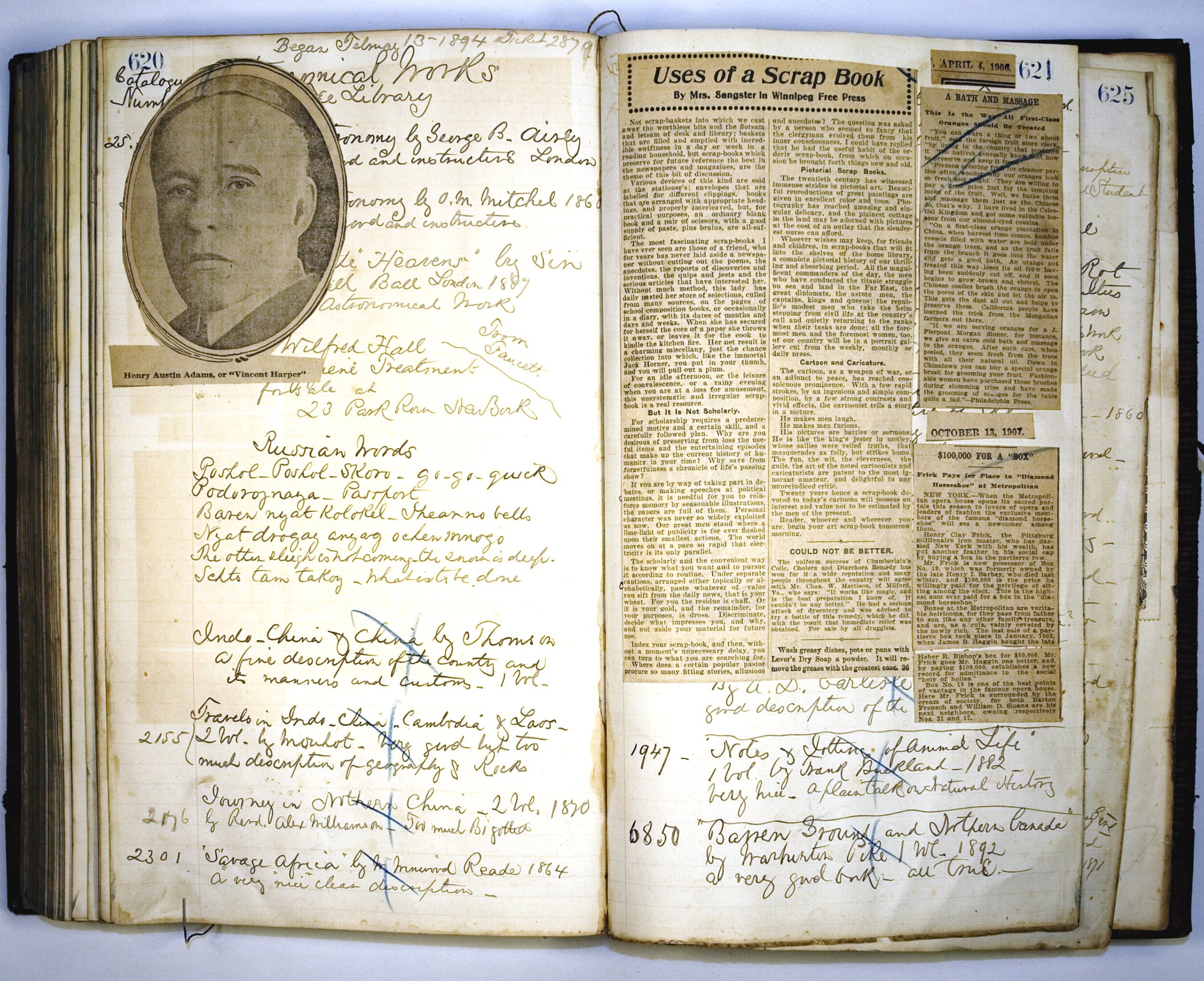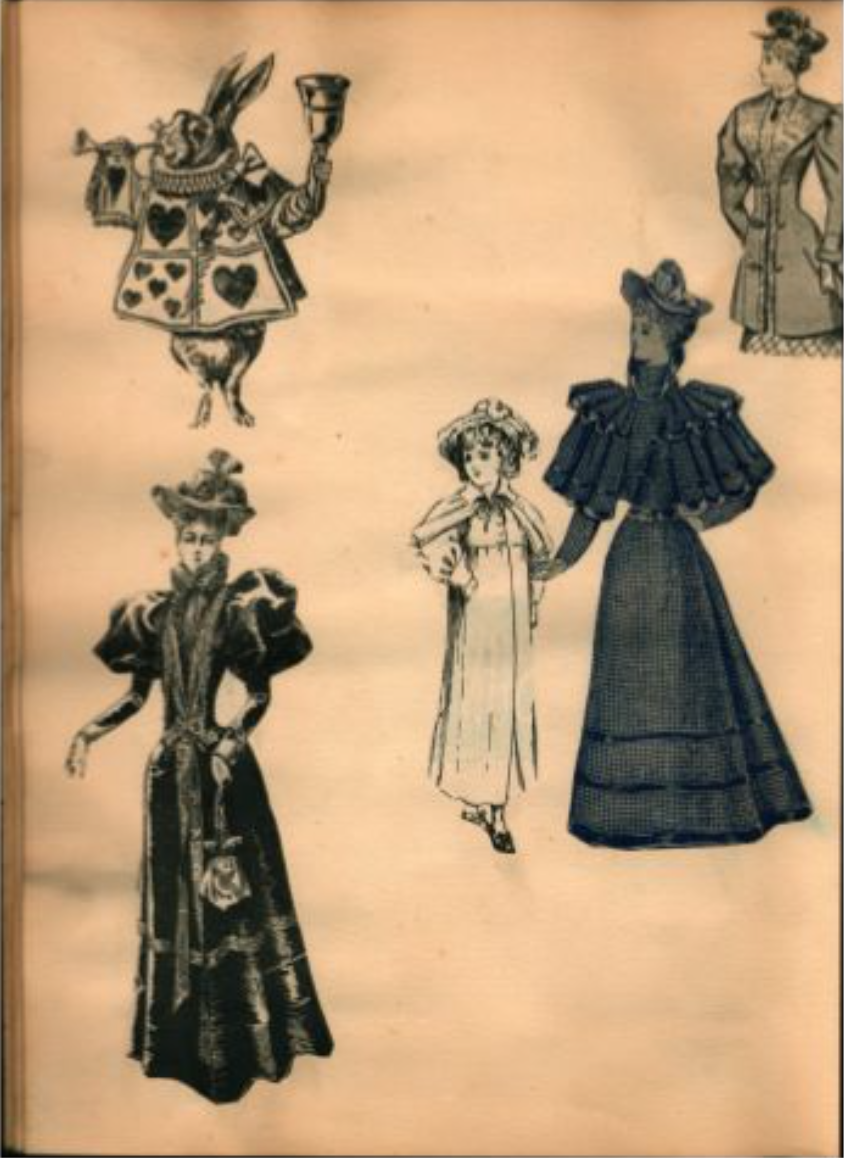
Victorian Scrapbooking
Workshop developed by Elizabeth Bassett and Heather Dean
Online tutorial created by Ruth Ormiston
Scrapbooking was a hugely popular activity in the Victorian era and was enjoyed by people of all backgrounds. While the specific term “scrapbook” only came into use in the nineteenth century, the practice of collecting things in books dates back to at least the sixteenth century. For example, scholars would keep commonplace books, in which they would copy important passages from their readings and index them for future reference, and European university students would collect inscriptions and illustrations from professors and fellow students in an album amicorum. While forms of scrapbooking were initially only accessible to upper-class and elite groups of people, this changed in the nineteenth century as printing technology advanced and cheap printed materials proliferated. By the end of the nineteenth century, scrapbooking was accessible to almost everyone, regardless of gender or social class.
Want to learn more about this craft? Click here for a list of scholarly readings, blogs and websites, instructional videos, extant examples, and 19th-century tutorials.
Types of Victorian scrapbooks
Victorian scrapbooks had many different looks and involved a variety of techniques.
Scissors-and-glue scrapbooks: These books were dominated by text-based materials in the first half of the nineteenth century; in the second half, visual materials became more common. The scrapbook itself was often a repurposed book: people used patent office reports, textbooks, government reports, ledgers, novels, and even Bibles. Blank albums were also manufactured specifically for scrapbooking.
Frank Sylvester Commonplace Book (from UVic Libraries Special Collections and University Archives: AR281)
Autograph albums: Victorians were fascinated with handwriting and believed that penmanship revealed truths about the writer. Many Victorians started collecting autographs in their scrapbooks from friends and even celebrities.
Scrapbookers didn’t just collect printed materials: they included locks of hair, pressed flowers, signatures, drawings, lyrics, and dedication inscriptions, among others. So get creative and think outside the box as you make your very own Victorian scrapbook!
Ella Kidman Autograph Album (from UVic Libraries Special Collections and University Archives: SC624)
You will need:
Blank book or piece of paper
Pages from Scrapbooking Workshop handout
Pencil
Black pen
Scissors
Glue (store-bought or homemade — see recipe in handout)
Dip pen + ink and non-absorbent paper or watercolour pencil/paint + fine brush and printer paper
Any other images, clippings, or objects you want to include in your scrapbook!
For Instructors: Visit our Crafting in the Classroom page for information on embodied learning, or click here for further resources about this craft.
Activity #1: Personalized title page
Many scrapbookers designed their title pages to imitate those of print books and included their name in large letters. Dedication verses were also popular additions to scrapbook title pages.
Materials: blank book or piece of paper, pencil, and black pen
Choose a verse (from the print-out or from the digital version of The Album Writer’s Friend) and copy it into your book. You can also add your name, illustrations, poetry, or anything else to personalize your title page. Make it representative of yourself!
Lilian Kidman Autograph Album (from UVic Libraries Special Collections and University Archives: SC624)
Activity #2: Ghost signatures
In the mid-nineteenth century, Victorians became fascinated with Klecksography: making art out of inkblots. As a result, inkblot signatures started showing up in albums by the end of the Victorian era and reached their height in the first decade of the twentieth century. Scrapbookers would collect these signatures from friends and celebrities.
Materials: dip pen + ink and non-absorbent paper or watercolour pencil or paint + fine brush and printer paper
Fold your paper in half and open it to create signing line.
Sign your name above the crease – make it as inky as possible.
Quickly refold your paper at the crease and open it to find your ghost signature!
Ella Kidman Autograph Album (from UVic Libraries Special Collections and University Archives: SC624)
Activity #3: Calling card page
Victorians often left calling cards for their hosts as mementos of social visits (people would display trays full of calling cards as a measure of their social circle). Calling cards were also pasted into scrapbooks. Alternatively, scrapbookers would trace shapes onto a page and have friends and family sign their names in the shapes to make them look like calling cards.
Materials: blank book, pencil and black pen, scissors, cut out calling card from handout (or business card/credit card)
Place your card anywhere on the blank page and trace around it in pencil.
Pick up your card and place it again in a way that overlaps with the existing trace.
Repeat until your page is full of overlapping calling card shapes.
Outline with pen.
Ask your friends and family to sign a “calling card”!
Activity #4: Scissors-and-glue scrapbooking
In the Victorian era, scrapbooks contained personally meaningful collections of a variety of materials: news clippings, photographs, letters, calling cards, holiday cards, etc. At the beginning of the nineteenth century, printing became cheaper and the production of newspapers increased exponentially. As a result, newspapers became aware that people were using their pages as scraps and publishers responded by printing tidbit sections (jokes, fun facts, household tips) for them to use. When colour printing developed in the latter half of the century, scrapbooks became more vibrant – retailers even sold chromolithography picture sheets for scrapbookers to use.
Materials: blank book, scissors, glue (store bought or homemade), print-out pages from the handout or your own scraps
Cut out your scraps, arrange, and paste however you want!
Muriel Gerrard Scrapbook (from UVic Libraries Special Collections and University Archives: SC236)
Please send us your own work-in-progress and/or finished creations! Email us at craftyvictorians@gmail.com, tweet us @craftyvictorian, or connect with us on Instagram @crafty_victorians.
Elizabeth Bassett
Elizabeth Bassett is a librarian and archivist from Vancouver Island, British Columbia. She holds a master’s degree in English from the University of Victoria (2016), as well as a dual master’s degree in Archival Studies and Library and Information Studies from the University of British Columbia (2021). While a graduate student, Elizabeth held archives assistant positions with the South Vancouver Island Dance Archives, the Vancouver Art Gallery, and the University of Victoria Libraries. Her research interests are focused on personal archives and literary archives.
Heather Dean
Heather Dean is Associate Director of Special Collections at the University of Victoria Libraries where she is responsible for managing rare print materials and private archives. Prior to joining the University of Victoria Libraries, she was an archivist with the Beinecke Rare Book and Manuscript Library at Yale University. She holds a Master of Arts in English Literature from the University of Victoria and Master of Archival Studies and Master in Library and Information Studies from the University of British Columbia.










